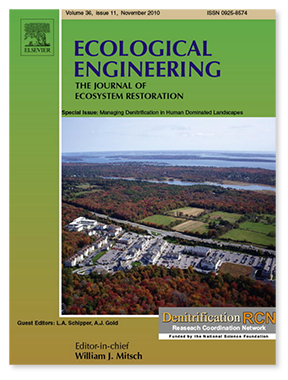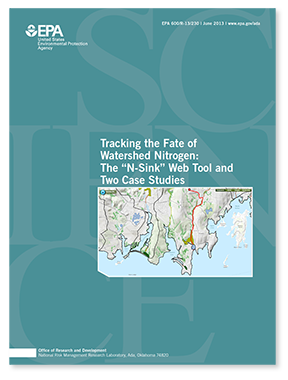About N-Sink
Why N-Sink?
Excess nitrogen (N) delivery via surface water to coastal estuaries contributes to impaired water quality evidenced by excess algal blooms and hypoxia. Hydrologic connections and flowpaths are influential in the delivery of nutrients to estuaries. Identifying landscape N sinks along hydrologic flowpaths – areas where dissolved N is transformed to gaseous N and effectively removed from the aquatic system – and their effect on N delivery at the watershed scale is important information for watershed managers, land use planners and conservation organizations. (See also our References list).
The intent of N-Sink, and its associated R package nsink, is as a screening tool to identify areas where downgradient N sinks are able to process excess N, versus areas where downgradient N sinks are less prevalent or effective at removing N. The latter argues for more aggressive N management at the source, while the former argues for protecting and/or restoring downgradient N sinks that are helping to reduce N delivery to estuaries.
N-Sink was developed as a web-based tool to visualize and explore landscape N sinks at the HUC-12 scale, and makes extensive use of widely available GIS data. The theoretical underpinnings are outlined in Kellogg et al. 2010 (below) and build on peer-reviewed meta-analyses and reviews to estimate N removal within landscape N sinks – wetlands, streams and ponds. Residence time in these landscape features is the primary driver of N retention and transformation.
N-Sink Maps
The nsink R package was written to simplify the acquisition and management of the spatial data necessary to estimate N removal within each identified landscape sink, estimate cumulative N removal along a specified flowpath, and create a set of static watershed maps. These maps are listed below. Sample map sets can be found on the Maps page, and explored interactively using the N-Sink tool:
(1) N Removal Efficiency, a color-coded map of the estimated N removal efficiency of the different landscape sinks;
(2) N Transport Index, a “heat” map with the cumulative N removal along flowpaths originating from a grid of points across a watershed, highlighting “leaky” areas with less downstream N retention vs. those with higher downstream retention; and
(3) N Delivery Index, combining maps (1) and (2) along with source loading based on National Land Cover Database categories, and expressed as an index ranging from 0 to 1, resulting in a map showing potential N delivery from different sources, taking into account the potential N removal as water moves downstream.
The Tool
The current (2021) version of N-Sink is now in Esri Story Map format, using ArcGIS Online. It includes not only the maps listed above, but also has a Watershed Analysis “dashboard” that breaks down the information for each watershed, and the N Tracker tool which allows the user to choose any point in a watershed and get the relative percent N removal from that point to the receiving water. Best of all, it covers all 76 coastal HUC-12 watersheds from the NY/CT border to the RI/MA border!

2010 paper on N-Sink prototype
READ REPORT
2013 EPA technical paper on N-Sink.
READ REPORT